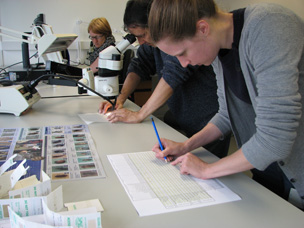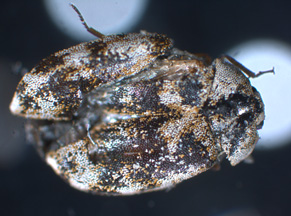I’m going to start this post off by saying I really don’t like bugs! Little creepy crawlies give me the shivers and at home I have to have my husband take responsibility for evicting any spiders that might have strayed into the house. However, at work I have to resist the urge to freak out at the sight of insects as monitoring them is regularly part of the job. From my point of view I’m thankful it’s not something I’m directly involved in and my thanks go out to my colleague Hannah Clare for the text below.

Collection care team identifying insects
The Collection Care Department manages an insect pest monitoring scheme that uses over 120 insect blunder traps. These have no attractant pheromone lure and simply collect insects as they walk across the trap’s sticky surface; they are the most commonly used insect traps in museums, libraries and archives as they provide a reflection of the number of insects to be found in a particular area.
The traps are laid out in a grid-like fashion in all document storage areas at The National Archives and once every quarter a team collect all the traps and exchange them for fresh ones. Then the process of examination of the traps, identification of the insects, counting and recording all the data begins. To help us identify what type of insects we have on the traps, we use a set of images of the most common pests found in heritage collections and compare them to what we see under the microscope. We have to research any we don’t recognise to make sure we identify all our finds correctly.

Guernsey Carpet Beetle
Sometimes what we find is not a direct risk to the collection, but the fact that they are there might suggest other risks. For example, an adult Guernsey Carpet Beetle is no threat to the collection in itself as it feeds on pollen from flowering plants. It can be transported inside by any traffic entering the archive. Its larvae, however, are a danger as they commonly feed on textiles and will also graze on the animal glue in book bindings. So it is important to monitor any pest presence in the collection. There is nearly always a certain number of insects within the storage areas of large collections, and monitoring ensures that numbers stay as low as possible.
However, pest monitoring can tell you more than just the threat of infestation. It is very important to closely examine the pest monitoring results and investigate any changes or anomalies in pest numbers as they can indicate that something else is amiss. Pest population change could suggest water ingress into the building or environmental equipment failure, and when used in conjunction with other monitoring programmes, potential problems can be quickly spotted and addressed.
To get a look at the types of insect pests found in heritage collections, check out the poster available for download from English Heritage.